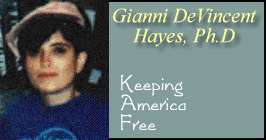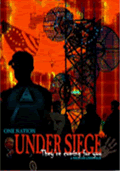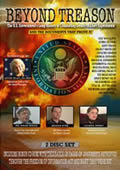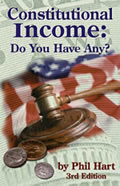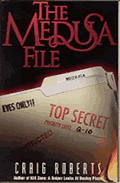Other
Hayes
Articles:
The Government's Take: What is Caesar's
CHEMICAL PLANT CHILDREN
By
Gianni DeVincent Hayes, Ph.D
November 12, 2006
NewsWithViews.com
The drug use/abuse situation in our country is not getting better; in fact, in many areas it�s worse than what is being reported. I spoke with a sheriff of a large county and his Major, and they told me that the general consensus among law enforcers is to place emphasis on stopping drug sales and use through education and prevention rather than trying to spend time, money, and manpower in seeking out and arresting users, and fighting to bring them to trial where they�re often let go or get off with a slap on the wrist. I have come to the conclusion that these high level officers are likely right. Just last week a drug agent told me that in New York City, druggies were selling plastic bags of cocaine for a mere $2.00, right in front of McDonalds. Our kids are walking chemical plants.
As a former professor and college department chair, I have seen young people stumble into my classrooms, stoned from substance abuse and/or wreaking of alcohol. They sit in class with glazed over eyes, lost in their own mental mire of millions of destroyed precious brain cells, much like rotting roadkill eaten by vultures. And these young people are our future. We adults are leaving our children a legacy, much as our parents and their parents before them have left us: A country to run and love and take care of. But many of today�s youth are so brain dead that they couldn�t take care of a pet let alone an entire nation. I worry about this a lot.
�My Generation Turned Out Okay�
For those of you who say �Gee, what�s the big deal�my generation did grass and pills and alcohol and we turned out just fine,� you ought to study the facts on what it is our kids are indulging in today because what they are ingesting, what they are manufacturing in underground labs, what they are mixing, what they are inhaling are all 15-25% more potent than the drugs of ten years ago, let alone those of the 1960s and �70s. And kids now have more drugs to choose from and additional ones are being invented on a regular basis, adding to their repertoire of selection. Ketamines, Fentanyl, GHB, tricyclidines, and phencyclidine are just a few. Don�t forget all those common household items they inhale, along with ordinary highlighters they sniff in classrooms. Perhaps most worrisome is the doctor-ordered prescription medications young people find in their homes and abuse, not only consuming them and sharing them with their friends or selling them, but also mutating them into even more potent addictive substances, such as Oxycontin. They use what intellect they have that�s not been drug-diseased to create new substances that are often fatal. Of course, not all of our children are users or abusers, but we need to keep it that way.
Speaking from Personal Experience
I�ve also seen more than I want in my lifetime of kids under the influence of substances. Years ago, I had sat in an auditorium full of people watching a high school play I had produced and directed. My young actors were doing a commendable job of performing when right behind me a young man stood up and pulled out a gun, pointed it at my actors, and then turned and pointed it at the parents and others watching the performance. He screamed obscenities. My students froze on stage. I jumped to my feet in protection of them and the gunman ran outside. I ran after him with a parent police officer at my heels. I grabbed the kid outside, and instantly I knew just by looking at his eyes that his mind had collapsed into the depths of hell; there was nothing behind them. It was the most eerie feeling I ever had. The officer and I talked the kid-gunman down, got his pistol, and got him to the hospital where we were told that he was so far gone that the damage to his brain was probably irreparable. Drugs had bear-hugged one more child.
I�ve experienced, too, the horrors of our youth driving drunk, ramming a tree and dying. Twice it�s happened in my front yard. In the first incident, a carload of teens whacked a tree. All died but two who were left physically mangled and comatose. The second time, a neighbor�s daughter�DUI�sped down our quiet, tree-lined development and cracked the trunk of a poplar tree so hard that I jolted out of bed�and at once knew what had happened; the sound of a thundering car smashing against a stationary object always stays with you. The driver�s seat jammed into the trunk, brain matter had spewed in the car, and the girl, only age 16, died�so did the tree whose site became a memorial.
Most devastating to me was the night a drunk driver slammed me through a car windshield. A week before college graduation, my date�who I had been seeing for several months--and I had gone to a party where everyone was drinking in celebration. When we entered the building, we went our separate ways. I drank with my friends but assumed that since he was the driver he was using good judgment. Besides, I thought, he was a big guy�about 6�4� and a few hundred pounds�who could handle any alcohol he consumed, especially with food at the party which would serve to slow down the metabolism of beer spreading into his bloodstream. It�s taken me a long time to admit how na�ve I was back then, and an even longer time to admit to the shame that had I not been drinking, I would have recognized his condition and not ridden with him; maybe even stopped him.
When it was time to leave, my date dropped his car keys and couldn�t pick them up. I distinctly recall asking him, �Can you drive? Are you sober?� I also remember that even in my own alcohol saturated cerebellum that I hesitated getting into his car. He reassured me he was fine.
He passed out at the wheel; hit a telephone pole and the front of a brick school building. The engine thrust upward through the floorboards trapping me from the waist down, after my face and top half of my torso flew through the window. Except for a fleeting moment when I came to and saw all the fire trucks, police cars, ambulances and people around me, and heard the sounds of the �jaws of life� wrenching and wresting to get me out of the entangled motor, the Lord spared me the horrors through unconsciousness.
My mother and brother got that horrid call at 2:00am telling them they immediately needed to drive the hundred-plus miles to the hospital where I lay insensate because it was unlikely I would live until the next morning. I was given Last Rites.
To date I have had about 14 facial reconstructive surgeries, the most recent in December 2005. I have lost part of my vision in one eye, have no bones on one side of my face which is being supported by wires and plates, and injured my hip and my arm. As time goes on, the trauma to my face worsens through loss of bone and muscle mass. When I�m tired, my damaged eye sags, and the pain in my hip flares up, as well as the tension in the sinews of my shoulder. I seldom ever get my picture taken, and if I must, I either have it taken on the good side of my face or ask the photographer to fix the defects on the other side of my face. I am now at a point where surgeons can do no more to help hide the permanent disfigurement. I wake every day and look in the mirror and think, �All this, all these years, for a spit second of fun.� The irony is that my date wanted to drive his motorcycle to the party and had even bought me a helmet, but that fateful night, the bike wouldn�t start. I guess God was looking over my shoulder. You know, I have never seen my date since then.
Even as I write this, I find the entire matter of what happened to me agonizing and grueling to deal with but it is important to me to spare our children from a life of permanent deformity and mental dysfunction from alcohol and drugs.
Learn What Your Children Are Doing
Although there isn�t a child who can enter or exit school and not be greeted by a dealer�some of whom are their own schoolmates� schools are at a loss as to how to win the skull & bones war of drug abuse, especially since many schools no longer offer drug prevention programs as DARE, and an even higher number have no PTA organization, so there is a lack of flow of information to parents on how they can save their children.
It�s erroneous to believe that only �troubled� youth and slackers are doing drugs. Good kids--honor students, athletes, and those coming from loving, sometimes strict and religious, homes�are unable to avoid drugs at school, parties, and friends� homes. �Raves� are a major source for the acquisition of drugs, experimentation with sex, and the practice of secrecy. Kids are engaging in these activities and doing drugs today as early as fifth grade, some even before this.
Why should we be worried about the drug and alcohol problem? These facts ought to zing anyone�s dull thinking on the issue:
Statistics on Youth and Substance Abuse
Nearly every child, of all ages and income levels, is offered drugs. Consider these facts:
-
The United States has the highest substance abuse rate of all industrialized nations.
-
America accounts for only 5% of the world's population, yet consumes 60% of the world's illicit drugs.
-
Over 35 million Americans are addicted to prescription and nonprescription medication.
-
18 million Americans are alcoholics. (�National Household Survey,� NIDA)
-
Nearly 20 million Americans use hashish or marijuana regularly.
-
Over 5 million people use cocaine or crack regularly.
-
Every day, 5000 people use cocaine or crack for the first time.
-
Today�s substances are at least 20 times more potent. Kids have a greater choice of more powerful, personality-altering drugs (such as Ecstasy, Ketamine, GHB) that not only put them in jeopardy, but also everyone around them.
-
88.5% of school aged children say it�s easy to get drugs.
-
More than 60% of youth who use marijuana before age 15 will use cocaine.
-
Over 54% of high school students will have used an illegal drug by the time they become seniors, with age 13 the average onset for use, though kids in middle school experiment.
-
1 out of every 2 kids has tried drugs.
-
2 out of 10 kids use illegal drugs or prescriptions, or alcohol regularly.
-
82% have used cocaine.
-
�Club drugs� are used at �raves� (parties) where supervision is lacking and secrecy, unsafe sex, and impaired judgment are present.
-
Before parents suspect it, their kids have been using drugs and alcohol for about two years.
-
Medical insurance policies have clauses allowing them to refuse medical claims if there was an illegal substance in the body, so parents pay ~$20,000-$30,000 per month to rehabilitate one addicted child.
-
The number of offenders under age 18 admitted to prison for drug offenses increased twelve-fold (from 70 to 840).
-
Parents are held legally responsible for their children�s actions, and several states have enacted the �Parental Responsibility Law� (PRL). Whether or not a state has passed the PRL, any type of damage done by a child must be paid for by parents, even if they don�t know their child is using substances.
Solution
My exposure to youth and substance abuse and my own horror of crashing through glass pushed me to find ways to prevent such ugly problems. I�ve spent a good portion of the last twenty-some years talking about the dangers of drinking and driving and overall substance abuse, to parents, to students and to MAD Impact meetings. Because of the gruesomeness of drug and alcohol intoxication, and the rise in addiction, I�ve decided to actively do something more hands-on about the crisis. I�ve put aside my professorship, lightened up on my love of writing books, and limited my social events, and instead have gone into the business of educating others about, and preventing, substance abuse�just as those law officers advised. I am doing this by providing drug and alcohol test kits to parents, along with substance abuse onsite testing to lawyers, law enforcers, treatment counselors, schools, churches, sports teams, and community organizations.
I offer moms and dads a �Parents� Program� which is designed to test their children in the privacy of their homes and know instantly what drugs their kids may be experimenting with or dependent on or addicted to. These drug kits detect alcohol levels and the presence of 10 different drugs (THC/marijuana, amphetamines, methamphetamines, phencyclidine [PCP], ecstasy, opiates, barbiturates, methadone, benzodiazepines, and cocaine). The package includes a detailed manual on everything there is to know about drugs and abuse, a phone helpline, a family pledge, directions on how to test an unwilling person, and other literature. Not only does this program give the drug status of those being tested, but it also serves as a great deterrent and preventive measure as well. When pressured by friends or others, youth have the excuse of saying, �No way, man. My parents randomly test me.� What a relief it is for them to get out of trying drugs without looking like a pansy in others� eyes. Young people--even employees and addicts under treatment--won�t do drugs if they know they�ll be randomly tested.
A lot of thought and money have gone into creating this �Parents� Program� but unfortunately many parents won�t consider it because they believe their children �wouldn�t ever try anything.� Or they tell me, �My kids will think I don�t trust them if I test them.� I answer that their children will get over that but that they won�t get over addiction. Perhaps parents don�t want to learn what their children do because they themselves indulge in illicit substances or they find it takes too much of their time to find out who their kids� friends are, what activities they�re involved in, what they do with their free time, and what they think.
Studies show that families who make a daily effort to sit down and have dinner together and talk about each others� days have decreased the likelihood that their kids will try drugs or alcohol, and thus stay off them not only through their rough growing-up years but potentially the rest of their lives. Similar studies demonstrate that parents who do sit down and discuss substance abuse repeatedly with their children find that their kids do avoid experimenting. And drug testing is an even greater tool in thwarting their even thinking about fooling with substances. Implementing rules for kids to follow and being consistent in disciplining them are arduous tasks, but preparing today�s youth as tomorrow�s �hope� is the obligation of parents�not a choice.
The problem is BIG; the solution is powerful.
We must test our kids, test employees, test sports teams, test youth in camps, test church groups. Testing our children--tomorrow�s presidents, tomorrow�s scientists, tomorrow�s clergy, tomorrow�s teachers, tomorrow�s doctors, tomorrow�s pharmacists, tomorrow�s workforce�gives us the opportunity to get them help before they are so deep into abuse that they can�t be saved.
|
Subscribe to the NewsWithViews Daily News Alerts! |
All adults should want to see our future leaders healthy and productive enough to guide a world they worked hard at giving them. We need to get involved in preventing our children from doing drugs before they enter the labyrinthine of an eternal Hades. Paying attention to them, talking to them, testing them are simple answers to complex issues. Why are we not doing that? Test kits are legal, safe, easy, and private, and so inexpensive�do we just not care? If we don�t help our own children, who will? Who would love our flesh and blood as much as we should--love them enough to protect them? When we brought them into this life we were already committed; why have we turned our backs on our jobs? Why have we shut our eyes to such a serious crisis? Is it all about us�or about them?
There is hope�if we take action.
*
Note: Statistics, unless otherwise noted, are from the �Drug Manual�
of Drug Testing Consultants, and literature from the United States
government.
� 2006 Gianni Hayes - All Rights
Reserved
Listen to Gianni Hayes on American Voice Radio
Sign Up For Free E-Mail Alerts
E-Mails are used strictly for NWVs alerts, not for sale
Dr. Gianni DeVincent Hayes is an internationally recognized author of 15 royalty-published books (www.creative-services.biz and www.amazon.com) and over 100 articles and short stories in highly circulated and commercial newspapers and magazines, such as PARADE, US, PEOPLE, REDBOOK, WOMAN'S DAY, MOODY, and many others. One of her novels,"22 Friar Street," had been under a movie option, and her novel on cloning, "Thy Brothers' Reaper," also had been optioned by a production company.
Hayes has a doctorate in writing/comparative literature /humanities, with a focus on eschatology (Bible prophecy and politics), and also has earned two masters in education and science. Her bachelor's degree is in the liberal arts, biology/chemistry. Certification has been achieved in writing at several universities, such as the University of Rochester, University of Pittsburgh, and Middlebury College's Breadloaf. She speaks worldwide and has appeared on dozens of national radio and TV shows.
Book her for speaking engagements.
E-Mail: ndhayes@att.net
We adults are leaving our children a legacy, much as our parents and their
parents before them have left us: A country to run and love and take care
of. But many of today�s youth are so brain dead that they couldn�t take
care of a pet let alone an entire nation. I worry about this a lot.

